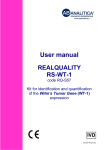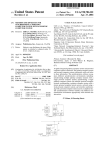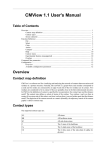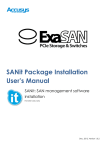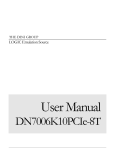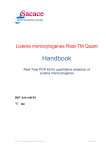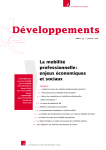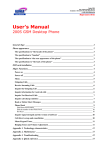Download Method and apparatus for determining the status of a transmission link
Transcript
USOO6484202B1
(12)
United States Patent
(10) Patent N0.:
(45) Date of Patent:
LeDuc et al.
(54)
METHOD AND APPARATUS FOR
DETERMINING THE STATUS OFA
6,335,932 B2 *
6,335,935 B2 *
US 6,484,202 B1
Nov. 19, 2002
1/2002 Kadambi et al. ......... .. 370/391
1/2002 Kadambi et al. ......... .. 370/396
TRANSMISSION LINK
*
(75)
Inventors: Douglas Edward LeDuc, Yorkville, IL
.
.
cued by exammer
(US); David Frank Simak, Wheaton,
IL (US)
.
.
Primary
Exammer—Moustafa
M. Meky
(74) Attorney) Agent» 0" Fi"m—J0hn B- Maclntyre
(73) Assignee: Lucent Technologies Inc., Murray Hill,
NJ (US)
Notice:
(57)
Subject to any disclaimer, the term of this
patent is extended or adjusted under 35
U.S.C. 154(b) by 0 days.
(21) Appl- N05 09/441,437
Nov_ 16, 1999
(22) Filed;
(51) Int. c1.7 .............................................. .. G06F 13/00
(52) US. Cl. ...................................... .. 709/224; 370/248
(58) Field of Search ............................... .. 704/200, 201,
704/212, 213, 224; 370/242, 244, 248,
251
R f
Ct d
(56)
e erences
l e
ABSTRACT
The present invention provides a method, apparatus, and
communication system (100) for determining the status of a
transmission link (108) betWeen a ?rst port (105) of a ?rst
device (104) and a second port (107) of a second device
(106). The communication system (100) includes a manage
met“ dew“ (112,23) TI: managemem?z“?h(102) mcludes
an 1_nput per“
an a Processed
6 management
devlce (102) tecelves a ?rst Status of the ?rst Port (105) and
a second status of the second port (107) on the input port
(103). The management device (102) calculates at the pro
cessor (116) the status of the transmission link (108) based
on the ?rst status and the second status.
U.S. PATENT DOCUMENTS
6,154,446 A
* 11/2000 Kadambi et a1. ......... .. 370/239
30 Claims, 3 Drawing Sheets
OUTPUT N118
PORT
MANAGEMENT
DEVICE
PROCESSOR R5102
1 1 a I ,114
MEMORY
INPUT N103
PORT
IIO
I 12
f'IOO
; 105
FIRST
FIRST
DEVICE
PORT
168
SECOND
SECOND
PORT
DEVICE
107 I
104 f
U.S. Patent
Nov. 19, 2002
Sheet 1 0f 3
OUTPUT
PORT
US 6,484,202 B1
~ I I8
MANAGEMENT
DEVICE
PROCESSOR ~IO2
1161 ,1 I4
MEMORY
INPUT
PORT
I106
;105
FIRST
DEVICE
FIRST
PORT
SECOND
PORT
107I
1041
FIG. 1
SECOND
DEVICE
U.S. Patent
Nov. 19, 2002
US 6,484,202 B1
Sheet 2 0f 3
LEAST
WEIGHT
GREATEST
< WEIGHT
>
OUT-OF-SERVICE OUT-OF-SERVIGE
AUTOMATIC
MAN UAL
205 I
204)
TESTING
203J
OUT-OF-SERVICE
FACILITY
PROBLEM
201J
202)
FIG. 2
;301
RECEIvE STATUS OF A FIRST PORT
,
,503
RECEIVE STATUS O F A SECOND PORT
I
I,
[305
CALCULATE THE STATUS OF THE
TRANSMISSION LINK BASED ON
FIRST STATUS AND SECOND STATUS
500
FIG. 3
IN-SERVICE
U.S. Patent
Nov. 19, 2002
Sheet 3 of3
US 6,484,202 B1
FIG. 4
4_0_Q
[401
CLEAR ALL BITS
403
{413
'3 PORT
SET OUT—OF—SERV|CE
Owl/3mg?“
MANUAL BIT
405
IS PORT
AUTOMAHC?
r415
AUTOMATIC BIT
;417
SET TESTING BIT
IS THERE
>
I419
AN OUT-OF-SERVICE
SET OUT—OF—SERVICE
FACHJTY PROBLEM?
FACILITY PROBLEM BIT
:
r421
|N'_S5EP£/FfgE?
Q10
T,
499
SET IN-SERVICE BIT
=
US 6,484,202 B1
1
2
METHOD AND APPARATUS FOR
DETERMINING THE STATUS OF A
TRANSMISSION LINK
The preferred embodiment of the present invention com
prises receiving at the management device a ?rst status of
the ?rst port and a second status of the second port. The ?rst
status is preferably determined at the ?rst device and sent to
the management device, While the second status of the
second device is preferably determined at the second device
and sent to the management device. The management
FIELD OF THE INVENTION
The present invention relates generally to communication
systems, and more particularly to a method and apparatus for
device, Which is preferably located remotely from the ?rst
determining the status of a transmission link in a commu
device and the second device, receives the ?rst status via a
?rst path and the second status via a second path that is
nication system.
10
distinct from the ?rst path. The ?rst path and the second path
BACKGROUND OF THE INVENTION
can be distinct from the transmission link. The management
device then calculates the status of the transmission link
Communication systems typically include multiple
based on the ?rst status and the second status.
devices that communicate With each other over links con
necting the devices. These links, commonly referred to as
15
transmission links, are typically Wirelines that run betWeen
ports on the devices.
Each device in a typical netWork knoWs the status of its
ports. HoWever, the device is typically not aWare of the
status of ports on other devices. Consequently, each device
does not knoW the status of the link, since the status of the
link is determined by the status of the tWo ports that the link
is connected to. Therefore, each device is only aWare of the
status of its link, and through that status, Whether the link
attached to the port is operational.
In the preferred embodiment, the step of calculating the
status of the transmission link comprises the step of setting
the status of the transmission link to the greater, or most
critical, of the ?rst status and the second status. Accordingly,
the status of the transmission link is calculated to be out
of-service if either the ?rst status or the second status
indicates that either link is out-of-service. An alarm can be
sent When the status is calculated to be a predetermined
value, such as an out-of-service alarm. In addition, a log can
25
Ports can have different statuses. For example, a port can
be updated When the status is calculated to be a predeter
mined value.
BRIEF DESCRIPTION OF THE DRAWINGS
be in-service, out-of-service, or testing. If a port is in an
out-of-service state, for example, a transmission link utiliZ
FIG. 1 depicts a communication system including a
management device coupled to a ?rst device and a second
ing that port typically cannot be used. HoWever, the port at
device in accordance With the preferred embodiment of the
present invention.
the other end of the transmission link is unaWare of the status
of the port on the other end, and in the vieW from that port,
the transmission link is operational.
One approach used to test a transmission link betWeen
tWo devices is referred to as a loop-back test. In a loop-back 35
process, a signal is sent over a transmission link from a ?rst
FIG. 2 depicts a state information block relating to the
state of a port in accordance With the preferred embodiment
of the present invention.
FIG. 3 depicts a ?oWchart for calculating the status of a
device to the second device. The message is immediately
“looped-back” to the ?rst device. In this manner, the trans
transmission link in accordance With the preferred embodi
ment of the present invention.
mission link can be tested to determine Whether the trans
FIG. 4 depicts a ?oWchart for determining the status of a
port of a device in accordance With the preferred embodi
ment of the present invention.
mission link is operational.
One problem With loop-back testing is that the transmis
sion link is out of service While the loop-back testing is
occurring. In addition, loop-back testing is typically a test
condition, meaning that it is operator-driven. Typically, a
loop-back test is performed after determining that there is a
problem With the transmission link. The loop-back test is
DESCRIPTION OF THE PREFERRED
EMBODIMENT(S)
45
just one test used to determine the state of the link.
Consequently, since the loop-back test is run only after an
Management device 102 preferably includes an input port
103, a processor 116, and memory 114. Input port 103 is
error has occurred, the loop-back test is not a real-time Way
of determining the status of the transmission link.
Therefore, a need exists for a method and apparatus that
effective in receiving a ?rst status of ?rst port 105 and a
second status of second port 107. Input port 103 is prefer
ably an Ethernet connection running TCP/IP (Transmission
Control Protocol/Internet Protocol). It should be understood
is able to determine in real-time the status of a transmission
link betWeen tWo devices.
SUMMARY OF THE INVENTION
FIG. 1 depicts a communication system 100 including a
management device 102 coupled to a ?rst device 104 and a
second device 106 in accordance With the preferred embodi
ment of the present invention.
55
that management device 102 can include a plurality of input
real-time solution to the aforementioned problem by utiliZ
ports, but only one is depicted for clarity. In the preferred
embodiment, management device 102 is located remotely
ing the states of a ?rst port and a second port to determine
the status of a transmission link disposed betWeen the ?rst
from ?rst device 104 and second device 106.
Processor 116 is effective for calculating the status of
and second ports.
The present invention provides a method, apparatus,
management device, and communication system for deter
sor 116 calculates the status of transmission link 108 based
on the ?rst status of ?rst port 105 and the second status of
It is an object of the present invention to provide a
transmission link 108. In the preferred embodiment, proces
second port 107.
mining the status of a transmission link betWeen a ?rst port
of a ?rst device and a second port of a second device. The
Memory 114 is effective in storing the status of transmis
?rst device and the second device can be a sWitch, a phone, 65 sion link 108. Memory 114 can be Random Access Memory
a computer, a modem pool, or any other piece of electronic
(RAM), electromagnetic, optical, ?ash, or any other media
equipment that is able to be coupled to another device.
effective in storing the status of transmission link 108.
US 6,484,202 B1
3
4
Management device 102 preferable includes an output
port 118 that is effective in outputting the status of trans
mission link 108. This port is preferably a Graphical User
done at a ?rst device to Which the ?rst port is connected, as
described beloW With regard to FIG. 4. In the preferred
embodiment of the present invention, the ?rst status of the
?rst port is sent from the ?rst device to the management
device. The ?rst status is preferably sent from the ?rst device
to the management device via a ?rst path that connects the
?rst device to the management device.
The management device receives (303) the second status
Interface (GUI), but can alternately be a command line
interface, a printer, a broWser, or a terminal. The port is
preferably connected to a monitoring device, such as a
terminal, personal computer, or Workstation, for operation
and use of the system.
Management device 102 is effective for determining the
status of a transmission link 108. Transmission link 108 is a
10
of a second port. The determination of the second status of
the second port is preferably done at a second device to
Which the second port is connected, as described beloW With
15
regard to FIG. 4. In the preferred embodiment of the present
invention, the second status of the second port is sent from
the second device to the management device. The second
status is preferably sent from the second device to the
management device via a second path that connects the
second device to the management device. In the preferred
embodiment, the ?rst path and the second path are distinct
link, such as T1, E1, DS3, E3, STS1, OC3, or OC12,
disposed betWeen a ?rst port 105 of a ?rst device and a
second port of a second device, the management device
comprising:
First device 104 is coupled to management device 102
and includes a ?rst port 105. First device 104 is preferably
a sWitch, but can alternately be a phone, a computer, a
modem pool, or any communication equipment that is
linked to another piece of communication equipment and
from each other. Alternately, the ?rst path and the second
path can be on the same link.
also linked to a management device.
The status of the transmission link betWeen the ?rst port
and the second port is then calculated (305) based at least in
Second device 106 is coupled to management device 102
and includes a second port 107. Second device 106 is
preferably a sWitch, but can alternately be a phone, a
computer, a modem pool, or any communication equipment
part upon the ?rst status and the second status. In the
preferred embodiment of the present invention, the calcula
tion is done at the management device. The management
device calculates the status of the transmission link by
setting the transmission link status to the most signi?cant bit
that is linked to another piece of communication equipment
and also linked to a management device.
Transmission link 108 couples ?rst device 104 and second
device 106 and is disposed betWeen ?rst port 105 and second
port 107.
In the preferred embodiment, ?rst device 104 is coupled
to management device 102 by ?rst path 110, and second
device 106 is coupled to management device 102 by second
path 112. First path 110 and second path 112 are preferably
distinct from each other, and paths 110 and 112 are also
preferably distinct from transmission link 108. By isolating
?rst path 110, second path 112, and transmission link 108,
3O
After calculating the status of the link, the management
device can send an alarm When the status is calculated to be
35
a predetermined value. For eXample, if the status is deter
mined to be out-of-service, an alarm can be sent to an
operator to alert the operator of the out-of-service state.
Further, the management device can update a log, such as an
error log, When the status is calculated to be a predetermined
value. This can assist in determining any conditions that lead
the status of the links can still be communicated When any
of the paths are doWn or non-operational.
FIG. 2 depicts state information 200 relating to the state
of a port in accordance With the preferred embodiment of the
present invention. State information 200 preferably includes
to error conditions. Still further, the status can be stored at
the management device or in memory coupled to the man
in-service bit 201, out-of-service facility problem bit 202,
testing bit 203, out-of-service automatic bit 204, and out
of-service manual bit 205. In the embodiment depicted in
FIG. 2, out-of-service manual bit 205 is the most signi?cant
bit, and in-service bit 201 is the least signi?cant bit.
In the preferred embodiment as depicted in FIG. 4, each
port has a state information block, and each of these bytes
is cleared prior to determining the status of the port. As the
state is checked, preferably from the most signi?cant end to
of the ?rst status and the second status.
As one example, if the ?rst status or the second status is
out-of-service, the status of the transmission link is calcu
lated to be out-of-service.
45
agement device. This stored status can then be used for
comparisons, calculations, or display at a later time.
FIG. 4 depicts a ?oWchart 400 for determining the status
of a port of a device in accordance With the preferred
embodiment of the present invention. In the preferred
embodiment of the present invention, the process of ?oW
chart 400 is accomplished in the ?rst device and the second
the least signi?cant end, a bit is set if a condition is found,
device. The ?rst device utiliZes ?oWchart 400 to determine
the status of the ?rst port. The second device utiliZes
?oWchart 400 to determine the status of the second port. In
and the byte is then returned. In the preferred embodiment,
the management device performs an ORing operation on the
the preferred embodiment, the ?rst device Will send the
status of the ?rst port to the management device, and the
tWo bytes. This sets the status of the transmission link
betWeen the tWo ports to the higher, or most signi?cant, of
the tWo ports that de?ne the transmission link.
FIG. 3 depicts a ?oWchart 300 for calculating the status of
a transmission link in accordance With the preferred embodi
ment of the present invention. In the preferred embodiment
55
betWeen the ?rst port and the second port.
The process of ?oWchart 400 is described beloW With
regard to the ?rst device determining the status of the ?rst
of the present invention, the management device calculates
the status of the transmission link. Alternately, the ?rst
port. It should be understood that the same process is
preferably utiliZed by the second device to determine the
status of the second port. For clarity, only a description of
the ?rst device determining the status of the ?rst port is
device or the second device can calculate the status of the
transmission link.
In accordance With the preferred embodiment, the man
agement device receives (301) the status of a ?rst port. The
determination of the ?rst status of the ?rst port is preferably
second device sends the status of the second port to the
management device. The management device uses these
status values to calculate the status of the transmission link
65
given beloW.
In accordance With the preferred embodiment, the ?rst
device clears (401) all bits. The ?rst device then determines
US 6,484,202 B1
6
5
(403) if the ?rst port is in an out-of-service manual mode.
While this invention has been described in terms of
Out-of-service manual mode refers to a situation Where a
certain examples thereof, it is not intended that it be limited
to the above description, but rather only to the extent set
forth in the claims that folloW.
The embodiment of this invention in Which an exclusive
technician instructs the system to take the port out-of
service. This is typically done for system maintenance
purposes. If the ?rst port is out-of-service, the ?rst device
sets (413) the out-of-service manual bit. The process then
property or privilege is claimed are de?ned as folloWs.
We claim:
1. A method for determining the status of a transmission
link betWeen a ?rst port of a ?rst device and a second port
ends (499).
If the ?rst port is not in out-of-service manual mode, the
?rst device determines (405) if the ?rst port is in an
out-of-service automatic mode. Out-of-service automatic
refers to a situation Where a device or port fails and the
10
receiving at a management device a ?rst status of the ?rst
port and a second status of the second port; and
system recovers from the failure. The recovery typically
leaves the device or port out-of-service automatic if the
calculating at the management device the status of the
failure cannot be repaired automatically through initialiZa
tion or other automatic action. If the ?rst port is in this mode,
the ?rst device sets (415) the out-of-service automatic bit.
15
The process then ends (499).
If the ?rst port is not in out-of-service automatic mode,
the ?rst device determines (407) if the ?rst port is in a testing
mode. determines (407) if the ?rst port is in a testing mode.
Testing mode refers to a situation Where the port is currently
management device located remotely from the ?rst device
25
facility problem mode. Out-of-service facility problem
mode refers to a situation Where a condition exists indicating
a problem in the signal received over the link from the other
port. This may be due to a physical severing of a cable or
?ber. If the ?rst port is in such a mode, the ?rst device sets
(419) the out-of-service facility problem bit, and then ends
(499).
35
means for receiving a ?rst status of the ?rst port and a
7. An apparatus in accordance With claim 6, Wherein the
means for receiving the ?rst status and the second status
currently in. In addition, although the preferred embodiment
utiliZes an ORing operation to choose the highest priority
45
The present invention thereby provides a method,
apparatus, and communication system for determining the
status of a transmission link. By sending the status of each
port to a management device, the management device is able
to calculate the status of the transmission link betWeen the
tWo ports based upon the status of each of the ports. In this
manner, a reliable calculation of the status of the transmis
and effectiveness.
Further, because the ports can send their status upon the
occurrence of a predetermined condition, the status of the
port of a second device, the apparatus comprising:
based on the ?rst status and the second status.
It should be understood that other factors can be consid
sion link is obtained, thereby increasing system reliability
and the second device.
3. A method for determining the status of a transmission
link in accordance With claim 1, Wherein the step of receiv
ing the ?rst status and the second status comprises the step
of receiving the ?rst status via a ?rst path and receiving the
second status via a second path.
4. A method for determining the status of a transmission
link in accordance With claim 3, Wherein the ?rst path and
the second path are distinct from each other.
5. A method for determining the status of a transmission
link in accordance With claim 3, Wherein the ?rst path and
the second path are distinct from the transmission link.
6. An apparatus for determining the status of a transmis
sion link betWeen a ?rst port of a ?rst device and a second
second status of the second port; and
means for calculating the status of the transmission link
ered When calculating the status of the ?rst and second ports.
Further, the factors can be placed in alternate orders to
change the priority of the conditions that each port is
selected to determine the state of the transmission link, other
operation could alternately be used to calculate the state of
the transmission link.
2. A method for determining the status of a transmission
of receiving the ?rst status and the second status at a
testing bit, and then ends (499).
If the ?rst port is not in an out-of-service facility problem
mode, the ?rst device determines (411) if the ?rst port is
in-service. In-service indicates that the port is operating
properly. If the ?rst port is in-service, the ?rst device sets
(421) the in-service bit, and the process then ends (499).
transmission link based on the ?rst status and the
second status.
link in accordance With claim 1, Wherein the step of receiv
ing the ?rst status and the second status comprises the step
involved in running a loop-back or other facility test. If the
?rst port is in a testing mode, the ?rst device sets (417) the
If the ?rst port is not in testing mode, the ?rst device
determines (409) if the ?rst port is in an out-of-service
of a second device, the method comprising the steps of:
55
comprises a management device.
8. An apparatus in accordance With claim 6, Wherein the
means for receiving is located remotely from the ?rst device
and the second device.
9. An apparatus in accordance With claim 6, Wherein the
means for receiving receives the ?rst status via a ?rst path
and receives the second status via a second path distinct
from the ?rst path.
10. An apparatus in accordance With claim 6, Wherein the
?rst path and the second path are distinct from the trans
mission link.
11. An apparatus in accordance With claim 6, Wherein the
means for calculating the status of the transmission link
comprises a management device.
12. Amethod for determining the status of a transmission
link betWeen a ?rst port of a ?rst device and a second port
link is determined by using the status of the ports, the
of a second device, the method comprising the steps of:
determining a ?rst status of the ?rst port;
determining a second status of the second port; and
calculating the status of the transmission link utiliZing the
transmission link does not need to be taken out of service in
order to test its status. By using the status of each of the ports
?rst status and the second status.
13. Amethod for determining the status of a transmission
transmission link can be monitored in a much more timely
fashion than the prior art. Since the status of the transmission
of the transmission link, a real-time or near real-time deter
link in accordance With claim 12, Wherein the step of
mination of the status of the transmission link can be 65 calculating the status of the transmission link comprises the
step of setting the status of the transmission link to the
obtained, Without the need to take the link out of service to
greater of the ?rst status and the second status.
run a loop-back or similar test.
US 6,484,202 B1
7
8
14. Amethod for determining the status of a transmission
link in accordance With claim 12, Wherein the status of the
transmission link is calculated to be out-of-service if either
23. A management device in accordance With claim 22,
the management device further comprising memory effec
tive to store the status of the transmission link.
the ?rst status or the second status is out-of-service.
15. Amethod for determining the status of a transmission
link in accordance With claim 12, the method further com
prising the step of sending an alarm When the status is
calculated to be a predetermined value.
16. Amethod for determining the status of a transmission
link in accordance With claim 12, the method further com
24. A management device in accordance With claim 22,
the management device further comprising an output port
effective to output the status of the transmission link.
25. A management device in accordance With claim 22,
Wherein:
10
lated to be a predetermined value.
17. Amethod for determining the status of a transmission
link in accordance With claim 12, Wherein the step of
determining the ?rst status of the ?rst port is performed at
the ?rst device.
15
18. Amethod for determining the status of a transmission
link in accordance With claim 17, the method further com
device to a management device.
19. Amethod for determining the status of a transmission
link in accordance With claim 12, Wherein the step of
determining the second status of the second port is per
19, further comprising the step of sending the second status
from the second device to a management device.
21. Amethod for determining the status of a transmission
link in accordance With claim 12, the method further com
prising the step of storing the status.
22. A management device for determining the status of a
transmission link betWeen a ?rst port of a ?rst device and a
second port of a second device, the management device
comprising:
an input port effective in receiving a ?rst status of the ?rst
port and a second status of the second port; and
a processor for calculating the status of the transmission
link based on the ?rst status and the second status.
the input port and the processor are located remote from
the ?rst device and the second device.
26. A management device in accordance With claim 25,
Wherein the input port receives the ?rst status and the second
status via a path other than the transmission link.
27. A communication system comprising:
prising the step of sending the ?rst status from the ?rst
formed at the second device.
20. A method for determining the state of a transmission
link in a communication system in accordance With claim
the ?rst status and the second status are associated With
the ?rst device and the second device, respectively; and
prising the step of updating a log When the status is calcu
25
a management device;
a ?rst device coupled to the management device and
including a ?rst port;
a second device coupled to the management device and
including a second port;
a transmission link coupling the ?rst port to the second
port; and
a processor for calculating the status of the transmission
link based at least in part upon the state of the ?rst port
and the second port.
28. Acommunication system in accordance With claim 27,
Wherein the ?rst device is selected from a group consisting
of a sWitch, a phone, a computer, and a modem pool.
29. Acommunication system in accordance With claim 27,
Wherein the second device is selected from a group consist
35 ing of a sWitch, a phone, a computer, and a modem pool.
30. Acommunication system in accordance With claim 27,
Wherein the processor is located in the management device.












